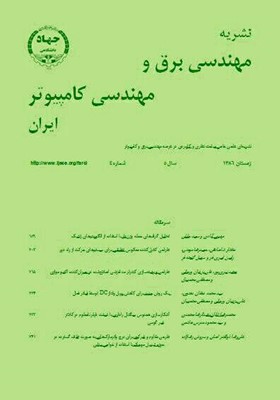روشي جديد براي طراحي كدهاي آزمون توازن كمچگالي در طول كوتاه
محورهای موضوعی : electrical and computer engineeringمهرداد تاکی 1 * , محمدباقر نظافتي 2
1 - دانشگاه قم
2 - دانشگاه صنعتی مالک اشتر تهران
کلید واژه: Extended Bit Filling, Semi - Random Parity Check matrix, finite length Irregular LDPC Codes,
چکیده مقاله :
در اين مقاله روشي جديد براي طراحي كدهاي آزمون توازن كمچگالي در طول كوتاه پيشنهاد ميشود. شبيهسازيها نشان ميدهند كه كدهاي طراحيشده در مقايسه با كدهاي LDPC طول كوتاه كه تاكنون طراحي شدهاند، از عملكرد بهتري برخوردارند. در ساخت كدهاي LDPC براي طولهاي كوتاه دو مسأله حائز اهميت است؛ اول آنكه پيشبيني تحليلي از عملكرد كد با استفاده از روش تكامل چگالي ، به دليل مبتنيبودن اين روش بر استفاده از بينهايتبودن طول كد، امكانپذير نيست. دوم اينكه با توجه به زيادبودن نسبي چگالي كد امكان بروز حلقههاي كوتاه در گراف متناظر كد بسيار زياد است و از آنجايي كه وجود حلقه در گراف كد باعث افت شديد عملكرد ميشود، اتخاذ روشي براي جلوگيري از ايجاد حلقه از اهميت بالايي برخوردار است. در اين مقاله براي هر دو مشكل فوق پيشنهاداتي ارائه شده است. اول آنكه ساختار كد بگونهاي انتخاب ميشود كه تا حد امكان عملكرد كد به آنچه روش تحليلي پيشبيني ميكند نزديك باشد، دوم اينكه با بهبود روش Extended Bit Filling روشي جديد براي كنترل حلقههاي گراف كد ارائه ميشود.
In this paper, we propose a new method for short block length Low Density Parity Check (LDPC) code design. The experimental results show that codes designed using the proposed algorithm have better performance compare to the other short block length LDPC codes. For LDPC code design in short block length, two problems arise: first analytical estimation of code performance using density evolution method is unusable because of infinity of code length in this method. Second because of high code density, the probability of short loop in code graph (Girth) is high that dramatically reduces the code performance. We propose solution for both problems. First, code structure is designed in such a way that the code performance is near to that of the density evolution method estimates and second by improving Extended Bit Filling algorithm, short block length is controlled.
[1] R. G. Gallager, Low Density Parity Check Codes, No. 21 in Research Monograph series, MIT Press, Cambridge, Mass., ???. 1963.
[2] D. J. C. MacKay and R. M. Neal, "Near Shannon limit performance low density parity check codes," Electronics Letters, vol. 32, no. 18, p. 1645, Aug. 1996.
[3] T. J. Richardson, M. A. Shokrollahi, and R. L. Urbanke, "Design of capacity - approaching irregular Low Density Parity Check Codes," IEEE Trans. on Information Theory, vol. 47, no. 2, pp. 619-637, Feb. 2001.
[4] Y. Xue and H. Xiang, "Performance analysis of finite - length LDPC codes," in Proc. 4th IEEE Workshop on Signal Processing Advances in Wireless Communications, SPAWC, pp. 85-89, Jun. 2003.
[5] C. Di, D. Proietti, I. E. Telatar, T. J. Richardson, and R. L. Urbanke, "Finite-length analysis of lowdensity parity-check codes on the binary erasure channel," IEEE Truns. on Information Theory, vol. 48, no. 6, pp. 1570-1579, Jun. 2002.
[6] J. Campello and D. S. Modha, "Extended bit - filling and LDPC code design," in IEEE Global Telecommunications Conf., vol. 2, pp. 985-989, Nov. 2001.
[7] L. Ping, W. K. Leung, and N. Phamdo, "Low - density parity - check codes with semi-random parity-check matrix," Elecrronic Letters, vol. 35, no. 1, pp. 38-39, Jan. 1999.
[8] H. Xiao - Yu, E. Eleftheriou, and D. M. Arnold, "Progressive edge - growth tanner graphs," in Proc. IEEE Global Telecommunications Conf., vol. 2, pp. 995-1001, Nov. 2001.
[9] C. Sae - Young, T. J. Richardson, and R. L. Urbanke, "Analysis of sum - product decoding of low - density parity - check codes using a Gaussian approximation," IEEE Trans. on Information Theory, vol. 47, no. 2, pp. 657-670, Feb. 2001.
[10] M. Rashidpour, A. Shokrollahi, and S. H. Jamali, "Optimal regular LDPC codes for the binary erasure channel," IEEE Communications Letters, vol. 9, no. 6, pp. 546-548, Jun. 2005.

